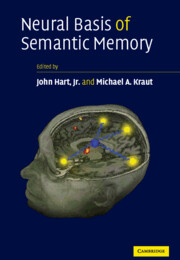Book contents
- Frontmatter
- Contents
- List of contributors
- Preface
- Part I Semantic Memory: Building Models from Lesions
- Part II Insights from Electrophysiology
- 3 Functional modularity of semantic memory revealed by event-related brain potentials
- 4 Bilingual semantic memory revisited – ERP and fMRI evidence
- Part III Applications of Models to Understanding Cognitive Dysfunction
- Part IV Representations of Nouns and Verbs vs. Objects and Actions
- Part V Critical Role of Subcortical Nuclei in Semantic Functions
- Part VI Conceptual Models of Semantics
- Index
- References
4 - Bilingual semantic memory revisited – ERP and fMRI evidence
from Part II - Insights from Electrophysiology
Published online by Cambridge University Press: 14 September 2009
- Frontmatter
- Contents
- List of contributors
- Preface
- Part I Semantic Memory: Building Models from Lesions
- Part II Insights from Electrophysiology
- 3 Functional modularity of semantic memory revealed by event-related brain potentials
- 4 Bilingual semantic memory revisited – ERP and fMRI evidence
- Part III Applications of Models to Understanding Cognitive Dysfunction
- Part IV Representations of Nouns and Verbs vs. Objects and Actions
- Part V Critical Role of Subcortical Nuclei in Semantic Functions
- Part VI Conceptual Models of Semantics
- Index
- References
Summary
Half a century ago, the linguist Uriel Weinreich (Weinreich, 1953) first characterized the way a bilingual's two languages relate to one another. Based on the way a bilingual actually acquired his or her two languages, he described so-called co-ordinative, sub-ordinative, and compound bilingualism (A, E, and F, respectively, in Figure 4.1). If we use a working definition of bilingualism in this chapter to pertain to anyone who can speak two or more languages, then a great deal of bilinguals are likely to be sub-ordinative, i.e. a native speaker of the first language (L1) and a late, or typical “school learner” of a second language (L2). However, the world is full of cultures and cross-cultural families in which individuals grow up with two or more languages. Right from the very start, such individuals can consequently be defined as compound bilinguals. Fifty years later, psycholinguistic experimental methodologies are well established, and measures such as event-related brain potentials (ERPs) and functional magnetic resonance imaging (fMRI) are increasingly used in the investigation of bilingual language processing. These methods now allow us to model the actual representations and neural basis of bilingual semantic memory based on Weinreich's initial typologies, expanding the typologies to refer to mental representations and not merely the way the L1 and L2 were acquired.
Most of the behavioral data that pertain to the models below were collected in the 1980s until now, using the methodologies of repetition and semantic priming (for semantic priming studies, see discussion below; for repetition priming, see Kirsner et al., 1980, 1984; Scarborough et al., 1984) and the picture–word interference paradigm (see Kroll & De Groot, 1997 for a review).
Keywords
- Type
- Chapter
- Information
- Neural Basis of Semantic Memory , pp. 105 - 130Publisher: Cambridge University PressPrint publication year: 2007
References
- 2
- Cited by

